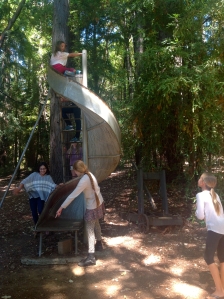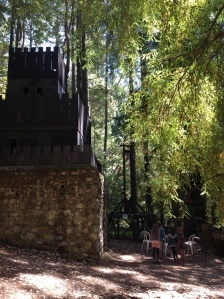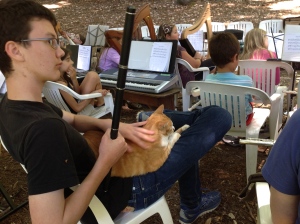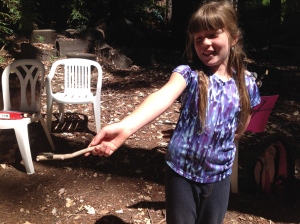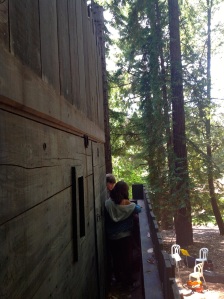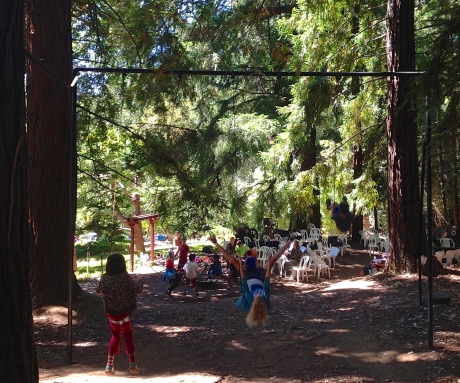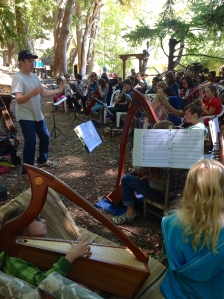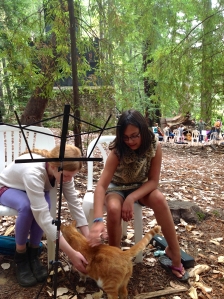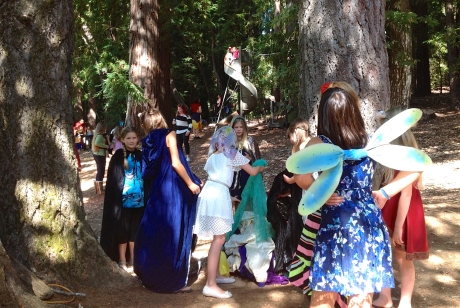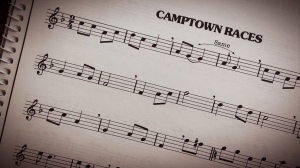Welcome to our first-ever virtual studio recital! I’m thrilled by the way this recording project has encouraged each of our students to view themselves as musicians who create sounds, reflect on what they hear, and then decide what they want to share with the world.
 Creating this recital has been a truly meaningful project, and it’s one that can only culminate by your listening – so thank you for being here!
Creating this recital has been a truly meaningful project, and it’s one that can only culminate by your listening – so thank you for being here!
Now, on with the tracks…
Will, piano, age 7: Giddy-Up, Pony!
“I thought Lisa was torturing me. We did it so many times! But actually, it was fun. I just started piano and I like knowing it.”
(Faber, My First Piano Adventure, Book B, pp. 10-11)
Eleanor, piano, age 8: The Black Cat Waltz
“I picked this song because it has both the color black and cats, which are my favorite. They are amazing and nothing can change that. Black cats are divine in their own way. #blackcat”
(Anne Shannon Demarest, Halloween Favorites: Book 1, p.12)
Fiorella, piano, age 8: Jimmy Jams
“I recorded this at my 7th piano lesson ever. I like how the fingers switch with my second finger reaching over. I also like how it keeps on going and how the notes are different but they are also related to each other.”
(Daniel McFarlane, Supersonics Piano Collection: Elementary, p. 6)
Josephine, piano, age 8: Russian Folk Dance
“I picked this song because it sounded cool. The end was hard because there were so many notes. Also the notes that are 3 beats long are tricky.”
(trad. Russian (“Во поле береза стояла”/”Beriozka”/”In the Field Stood a Birch Tree”) in Faber, My First Piano Adventure, Book B, pp. 32-33)
Colin, piano, age 9: Moonrise Improvisation
“I picked this song because I liked creating the melody of it. I started piano about six weeks ago and this was one of the first things I did.”
(Forrest Kinney, Create First!: Making Music the Pattern Play Way, Duet Book 1, p. 7)
Dalilah, piano, age 9: Baby Owl
“I’ve been learning cool tricks you can do on piano, like last year when we started changing hand position in the same song. I picked Baby Owl because it was my favorite song we played and it sounded like Halloween and I liked Halloween. I decided to make it sound like a hip hop sound for this song because I really like hip hop. I am going to Hip Hop Nutcracker tomorrow.”
(Faber, My First Piano Adventure, Book C, pp. 22-23)
Lydia, piano, age 9: Ode to Joy
“What’s it like to play piano? It’s loud. My advice for people who want to learn piano is, don’t hit the keys too hard.”
(Theme from Beethoven’s Symphony #9 in d minor, arranged in Faber, My First Piano Adventure, Book B, pp. 12-13)
Madeline, piano, age 11: Love Somebody
“I found my song in my band book and decided to find chords that would be good on that song. So I played it on clarinet and then added a synthesizer part. The best part is the end.”
(Madeline’s own arrangement of Doris Day & Buddy Clark’s 1947 song using Bruce Pearson & Ryan Nowlin’s duet version in Tradition of Excellence: Comprehensive Band Method, p. 9)
Sam, piano, age 11: Dungeon Run
“I picked this song because it sounds awesome even though there’s nothing really tricky about playing it.”
(Daniel McFarlane, Supersonics Piano Collection: Elementary, p. 8)
Avery, flute, age 12: Hedwig’s Theme
“I like this song because it’s from Harry Potter! I am learning about longer phrases and so this was a way to challenge myself.”
(John Williams/arr. Dan Coates. Adapted from printed version in Harry Potter: Sheet Music from the Complete Film Series)
Maggie, flute, age 12: Angels We Have Heard on High
“I started band on clarinet and changed to flute this year. The hard part is not changing your fingers when you go high, because you use your lips for that. I feel like I’ve made a lot of progress in the past few months!”
(trad. French (“Les Anges dans nos Campagnes”); arrangement taken from Mizzy McCaskill & Dona Gilliam’s Christmas Solos for Beginning Flute, Vol. 1)
Vanessa, piano, age 12: Flight over the Mountains
“A generous friend’s gift of a piano inspired me to take lessons. I care a lot about which songs I choose to learn. I decided I wanted to play this one for the recital because it sounds the best and I really like it.”
(Daniel McFarlane, Supersonics Piano Collection: Elementary, p. 16)
Jonathan, flute, age 13: Manx Waltzes (Arrane Ghelby & Ushag Veg Ruy)
“I enjoy how traditional music gives me a different experience from what I play most of the time in school. I like how these two waltzes complement each other and how putting them together makes a new song.”
(trad. Isle of Man, The Waltz Book 2 (Bill Matthiesen, ed.), p. 35)
Lilly, flute, age 15: Valse des Fables
“I really love how rich the flute can sound in the low notes. Using tone in an intentional way is something I’m thinking about lately.”
(Adam Broome, The Waltz Book 4 (Bill Matthiesen, ed.), p. 79)
Adele, flute, age 18: To Drive the Cold Winter Away
“Even though I’ve been a musician for eight years, I had never tackled a project like this. Creating this arrangement helped me learn to trust my ability to put sounds together and make them into something new. I had also never written music before, and now I know how to write a harmony part as well. I feel that I have become a better, more well-rounded musician because of this project.”
(trad. English, 16th-17th c.; original arrangement by Adele using Suzanne Guldiman’s version in Green Grows the Holly: Medieval and Renaissance Christmas Carols Arranged for Lap Harp as a starting point)

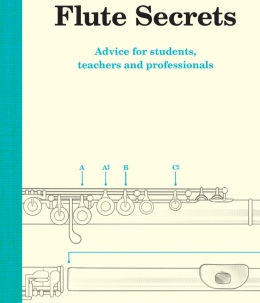 So when I saw that he had published
So when I saw that he had published  It feels nearly impossible to write, though. What can you possibly say about someone who had such a profound impact on you?
It feels nearly impossible to write, though. What can you possibly say about someone who had such a profound impact on you? It’s not an exaggeration to say those two-hour sessions were the highlight of my week.
It’s not an exaggeration to say those two-hour sessions were the highlight of my week.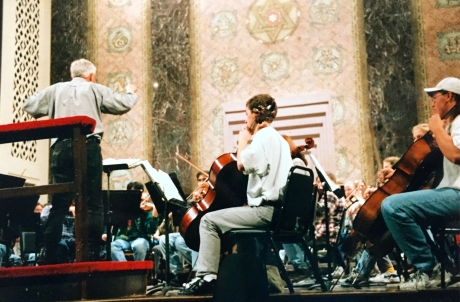 He also took great care to communicate that the way we related to each other was part of our musicianship. Mr. Holt created an ethos in which we strove for excellence, together, as a group. He talked about having a ‘friendly competition’ with your stand partner, that the two of you should be egging each other on in the best way possible: who can play with the most care for the dynamic markings? Who never misses an accent or an entrance? When you hear the other person do something you like, can you copy it the next time it comes around?
He also took great care to communicate that the way we related to each other was part of our musicianship. Mr. Holt created an ethos in which we strove for excellence, together, as a group. He talked about having a ‘friendly competition’ with your stand partner, that the two of you should be egging each other on in the best way possible: who can play with the most care for the dynamic markings? Who never misses an accent or an entrance? When you hear the other person do something you like, can you copy it the next time it comes around?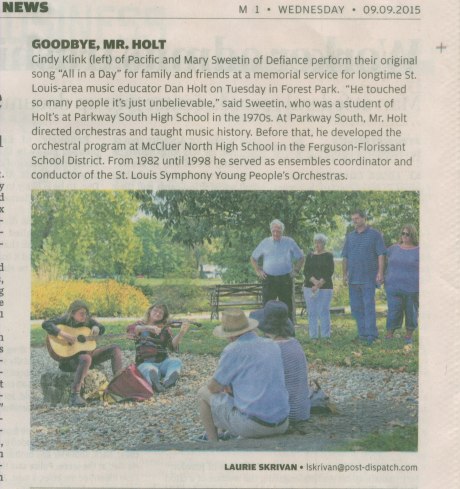 He was the first teacher I ever saw apologize to a student. He did it from the podium, took his time, and was so sincere. (We hardly knew how to react.)
He was the first teacher I ever saw apologize to a student. He did it from the podium, took his time, and was so sincere. (We hardly knew how to react.)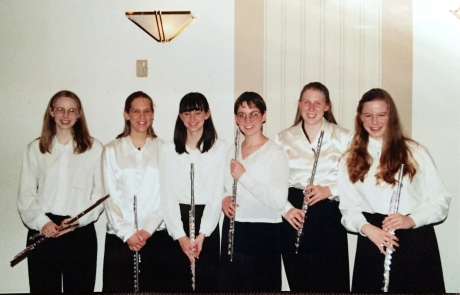 But more than this: my mother reminds me of a time I broke a viola string in the first piece on a concert. He held the whole orchestra while I ran backstage to replace it, just so I could play on the second piece too.
But more than this: my mother reminds me of a time I broke a viola string in the first piece on a concert. He held the whole orchestra while I ran backstage to replace it, just so I could play on the second piece too.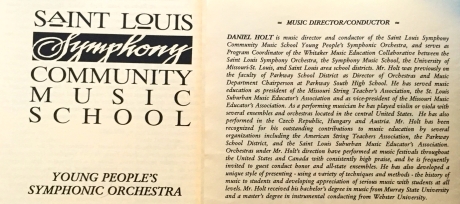 If, like me, you’re hearing this sad news a little late: there’s
If, like me, you’re hearing this sad news a little late: there’s 
